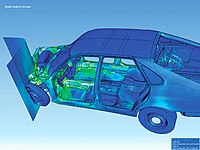
Photo from wikipedia
Abstract We compared the capture efficiency of three traditional sampling methods, hand captures at day, hand captures at night and captures by commercial baited traps (“Pirat type”) with a coarse… Click to show full abstract
Abstract We compared the capture efficiency of three traditional sampling methods, hand captures at day, hand captures at night and captures by commercial baited traps (“Pirat type”) with a coarse mesh size of 10 × 45 mm, for the native crayfish species Austropotamobius torrentium (stone crayfish) and Astacus astacus (noble crayfish). These capture types are applied regularly in monitoring programs. Additionally, we tested modified traps with fine mesh size to capture stone crayfish. We hypothesized that the capture efficiency of the methods is different between the two species, different sex and size classes and seasons and that modified traps with small mesh size were more effective in capturing juvenile stone crayfish than traps with coarse mesh size. Hand captures at night were found to be the most effective sampling method for both species. It generates the highest relative abundances and is the least biased method in relation to size and sex of crayfish specimen. Hand captures at day result in lower capture rates than hand captures at night. However, there is a tendency to gather more small individuals and females in comparison to the night captures. Baited traps turned out to be completely inappropriate for capturing stone crayfish; even traps modified with small mesh size were not a suitable capture method. For noble crayfish all three methods seem to be suitable, depending on the sampling purposes. The relative differences between the methods did not change significantly during the seasons. However, when capture rates of all three methods were combined, September was found to be the month where the highest capture rates were achieved as both sexes of both species were on the peak of their activity.
Journal Title: Limnologica
Year Published: 2020
Link to full text (if available)
Share on Social Media: Sign Up to like & get
recommendations!